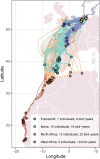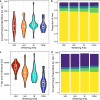Energetic and behavioral consequences of migration: an empirical evaluation in the context of the full annual cycle
- PMID: 36681726
- PMCID: PMC9867707
- DOI: 10.1038/s41598-023-28198-8
Energetic and behavioral consequences of migration: an empirical evaluation in the context of the full annual cycle
Abstract
Seasonal migrations are used by diverse animal taxa, yet the costs and benefits of migrating have rarely been empirically examined. The aim of this study was to determine how migration influences two ecological currencies, energy expenditure and time allocated towards different behaviors, in a full annual cycle context. We compare these currencies among lesser black-backed gulls that range from short- (< 250 km) to long-distance (> 4500 km) migrants. Daily time-activity budgets were reconstructed from tri-axial acceleration and GPS, which, in conjunction with a bioenergetics model to estimate thermoregulatory costs, enabled us to estimate daily energy expenditure throughout the year. We found that migration strategy had no effect on annual energy expenditure, however, energy expenditure through time deviated more from the annual average as migration distance increased. Patterns in time-activity budgets were similar across strategies, suggesting migration strategy does not limit behavioral adjustments required for other annual cycle stages (breeding, molt, wintering). Variation among individuals using the same strategy was high, suggesting that daily behavioral decisions (e.g. foraging strategy) contribute more towards energy expenditure than an individual's migration strategy. These findings provide unprecedented new understanding regarding the relative importance of fine versus broad-scale behavioral strategies towards annual energy expenditures.
© 2023. The Author(s).
Conflict of interest statement
The authors declare no competing interests.
Figures





References
-
- Alerstam T, Hedenström A, Åkesson S. Long-distance migration: Evolution and determinants. Oikos. 2003;103:247–260. doi: 10.1034/j.1600-0706.2003.12559.x. - DOI
-
- Somveille M, Rodrigues ASL, Manica A. Why do birds migrate? A macroecological perspective. Glob. Ecol. Biogeogr. 2015;24:664–674. doi: 10.1111/geb.12298. - DOI
-
- Tatner P, Bryant DM. Flight cost of a small passerine measured using doubly labeled water: Implications for energetics studies. Auk. 1986;103:169–180. doi: 10.2307/4086976. - DOI
-
- Boisclair D, Leggett WC. The importance of activity in bioenergetics models applied to actively foraging fishes. Can. J. Fish. Aquat. Sci. 1989;46:1859–1867. doi: 10.1139/f89-234. - DOI
Publication types
MeSH terms
LinkOut - more resources
Full Text Sources

